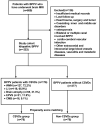The influence of cerebral small vessel diseases on the efficacy of repositioning therapy and prognosis of benign paroxysmal positional vertigo
- PMID: 35928725
- PMCID: PMC9346385
- DOI: 10.7150/ijms.73080
The influence of cerebral small vessel diseases on the efficacy of repositioning therapy and prognosis of benign paroxysmal positional vertigo
Abstract
Background: Although vascular risk factors have been found to be closely related to the development of benign paroxysmal positional vertigo (BPPV), the relationship between BPPV and cerebral small vessels diseases (CSVDs) has rarely been discussed in literature. This study set out to investigate the efficacy of repositioning therapy and prognosis among BPPV patients with CSVDs. Methods: We enrolled 553 BPPV patients who had undergone brain MRI, and categorized them into two groups based on the presence or absence of CSVDs. After controlling for other confounders using a propensity score matching (PSM) approach, we compared the incidence of recurrence and residual dizziness (RD). Then, we analyzed the recurrence rate and RD incidence in 176 BPPV patients with CSVDs, and assessed potential risk factors. Results: White matter hyperintensity (WMH, 72.2%) and lacunar infarction (LI, 65.9%) were the two CSVDs that were present in the highest proportion among the BPPV patients. The incidence of RD in patients with CSVDs was significantly higher compared to subjects without CSVDs. Patients with RD (n=100, 56.8%) were older, had more severe WMH, and had a higher incidence of brain atrophy; age and higher Fazekas score were independent risk factors. Among the recurrent patients (n=61, 34.7%), the ages were older, the Fazekas score of WMH was higher, and number of LIs was increased; age was the sole independent risk factor. Conclusion: BPPV patients with a combination of CSVD comorbidities, especially elderly patients with WMHs, are more likely to develop RD, which needs to be paid more attention.
Keywords: BPPV; Benign paroxysmal positional vertigo; CSVD; Cerebral small vessels diseases; Recurrence; Residual dizziness; White matter hyperintensity.
© The author(s).
Conflict of interest statement
Competing Interests: The authors have declared that no competing interest exists.
Figures
Similar articles
-
Correlation of idiopathic benign paroxysmal positional vertigo with cerebral small vessel disease.Am J Emerg Med. 2023 Dec;74:140-145. doi: 10.1016/j.ajem.2023.09.048. Epub 2023 Oct 6. Am J Emerg Med. 2023. PMID: 37837822
-
Analysis of influencing factors of residual dizziness after repositioning of horizontal semicircular canal benign paroxysmal positional vertigo.Acta Otolaryngol. 2024 Nov-Dec;144(11-12):610-614. doi: 10.1080/00016489.2024.2416079. Epub 2024 Nov 2. Acta Otolaryngol. 2024. PMID: 39487732
-
Risk factors for residual dizziness after successful repositioning in elderly patients with benign paroxysmal positional vertigo.J Clin Neurosci. 2025 May;135:111076. doi: 10.1016/j.jocn.2025.111076. Epub 2025 Feb 17. J Clin Neurosci. 2025. PMID: 39965514
-
Treatment and recurrence of traumatic versus idiopathic benign paroxysmal positional vertigo: a meta-analysis.Acta Otolaryngol. 2019 Sep;139(9):727-733. doi: 10.1080/00016489.2019.1632484. Epub 2019 Jul 3. Acta Otolaryngol. 2019. PMID: 31268396 Review.
-
Benign paroxysmal positional vertigo in the elderly: current insights.Clin Interv Aging. 2018 Nov 5;13:2251-2266. doi: 10.2147/CIA.S144134. eCollection 2018. Clin Interv Aging. 2018. PMID: 30464434 Free PMC article. Review.
Cited by
-
Otolithic functions in patients with residual dizziness after successful repositioning manoeuvres for unilateral posterior canal BPPV.J Int Med Res. 2024 May;52(5):3000605241249095. doi: 10.1177/03000605241249095. J Int Med Res. 2024. PMID: 38726874 Free PMC article.
-
Risk factors for benign paroxysmal positional vertigo and construction of a nomogram predictive model.Am J Transl Res. 2024 Jun 15;16(6):2435-2444. doi: 10.62347/DHAJ4799. eCollection 2024. Am J Transl Res. 2024. PMID: 39006265 Free PMC article.
-
Residual dizziness after BPPV management: exploring pathophysiology and treatment beyond canalith repositioning maneuvers.Front Neurol. 2024 May 24;15:1382196. doi: 10.3389/fneur.2024.1382196. eCollection 2024. Front Neurol. 2024. PMID: 38854956 Free PMC article. Review.
References
-
- Kim JS, Zee DS. Clinical practice. Benign paroxysmal positional vertigo. N Engl J Med. 2014;370:1138–47. - PubMed
-
- Bhattacharyya N, Gubbels SP, Schwartz SR, Edlow JA, El-Kashlan H, Fife T. et al. Clinical Practice Guideline: Benign Paroxysmal Positional Vertigo (Update) Otolaryngol Head Neck Surg. 2017;156:S1–s47. - PubMed
-
- Maas B, Bruintjes TD, van der Zaag-Loonen HJ, Winters SM, Masius-Olthof S, Colijn C. et al. Physical and Emotional Burden of the Epley Maneuver in the Elderly. Otol Neurotol. 2019;40:1082–7. - PubMed
MeSH terms
LinkOut - more resources
Full Text Sources
Medical
Miscellaneous


